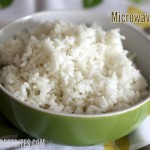 I’ve had this post planned for almost a year now. When we first started the blog, I posted a super basic tutorial on how to cook white rice. Seriously…like the instructions on the rice bag (I promise, if we posted that same thing today, we’d get 50 mean emails about how our blog has gone downhill and we’re just skating by with stupid posts.) However, since we moved to Louisiana (also known as The Land Where No One Eats Potatoes, Just Rice), I’ve learned a lot about cooking rice, different types of rice, and how to troubleshoot some common problems like crunchy or soggy rice.
I’ve had this post planned for almost a year now. When we first started the blog, I posted a super basic tutorial on how to cook white rice. Seriously…like the instructions on the rice bag (I promise, if we posted that same thing today, we’d get 50 mean emails about how our blog has gone downhill and we’re just skating by with stupid posts.) However, since we moved to Louisiana (also known as The Land Where No One Eats Potatoes, Just Rice), I’ve learned a lot about cooking rice, different types of rice, and how to troubleshoot some common problems like crunchy or soggy rice.
Let me preface everything by saying that I have had bad luck with rice cookers. I know that’s not the case for everyone, and I’ve had good rice cooked in rice cookers, but I’ve never found a rice cooker that works for me; it’s always been somehow burned and undercooked at the same time. But maybe someday I’ll continue my quest for a good rice cooker… 🙂
So last fall, I went out and shopped for all different kinds of rice and had grand plans for a big ricey post full of riciness. And then I got myself [insert your favorite lighthearted pregnancy euphemism here; careful, you don’t wanna be called “unclassy”] and the smell of rice cooking did bad things to me. And then it was hot outside and it felt weird to talk about rice when it was hot outside. So here we are. A year later, no longer pregnant and ricier than ever.
First, let’s talk about different types of white rice. You have your regular old rice that comes in different grains (short, medium, long, and extra long). There was a time when I never really thought about what grain my rice was, but I have since become an almost exclusively long- or extra-long rice kind of gal.
As a general rule, the shorter the rice, the softer and stickier it is. That can be good or bad. Making sushi rice? Short-grain rice (or sushi rice, which is short-grain) is the way to go. Making something like a pilaf or fried rice where you want individual rice kernels? Long or extra-long is your best bet. When it comes to just basic white rice, I don’t like mine overly sticky or soft, so I like the longer grains.
You also have the specialty rices like arborio, basmati, and jasmine rice.
Arborio is a flat, short-grain Italian rice that is used in risotto. And the short grain is part of what makes risotto so creamy and comforting. Basmati is a long-grain fragrant Indian rice that is good in stuff like our Coconut Rice. Jasmine rice is similar to basmati rice, but it’s grown in Thailand, has a shorter grain, and is cheaper.
There’s also parboiled rice, which is white rice that is partially boiled and/or steamed while it’s still in the husk, so it takes on some of the nutritional benefits of brown rice. The only brand I’ve ever seen is Uncle Ben’s parboiled rice, although I know it’s also sold in Asian markets under different names. I was stupid and didn’t get a picture of it, but it is browner than regular white rice. Like long-grain rice, parboiled rice is firm and not sticky at all. When it comes to cooking parboiled, jasmine and basmati rice, you cook them pretty much how you would cook regular, white, all-purpose rice.
Wow. This could be the most boring blog post ever. I sound like a fricking rice textbook.
So anyway. Let’s talk about how to cook white rice.
I always did the standard twice as much water as rice, bring to a boil, cover, reduce heat, and steam for 20 minutes. Which was usually okay in Utah, which is at a very high altitude, but when we moved to Louisiana, my rice was almost always unbearably soggy. And I realized it was probably the elevation. So I’ve started adjusting the water depending on where I am when I’m cooking rice and it’s been so much better!
Cooking Rice on the Stovetop
When it comes to basic, classic rice, I usually cook it on the stovetop. Up until recently, I’ve always used a regular saucepan to cook rice, but I’ve recently started cooking my rice in a skillet instead of a saucepan.
I’ve found that the rice cooks more evenly and just better when it’s not piled quite so high like it is in a saucepan.
To make it on the stovetop, you can either place the rice in the skillet…
or heat the skillet over medium with 1 teaspoon of oil or butter per cup of rice. When the oil is hot, add the rice and toast it for 30-60 seconds or until the rice smells distinctly “ricey” (don’t over-toast it, though–it will make your rice tough if you do) before adding your liquid. Toasting the rice adds a subtle flavor dimension and also improves the overall texture of your finished rice.
When it comes to cooking liquid, I’ve found that if I’m at a normal elevation, the regular 2 parts water/1 part rice rule still works great. If I’m at a low elevation, though, I cut back on the liquid by 2 tablespoons and if I’m at a high elevation, increasing the liquid by 2 tablespoons helps ensure the rice is tender. You can also add 1 teaspoon white or white wine vinegar per cup of water (or broth). It also helps improve the final texture of the rice. Just be sure to add the vinegar first to the measuring cup and then fill the rest with water to make sure you don’t have too much cooking liquid.
So add the liquid to rice (toasted or untoasted) in the skillet, cover, and bring to a boil over medium-high heat. Reduce heat to a simmer (make sure the rice is simmering and that when you reduce the heat, it isn’t just sitting there in water that isn’t doing anything) and cook for 20 minutes. Again, in lower elevations, you may need a little less time and in higher elevations, you might need a few more minutes to make sure the water has been absorbed. The surface should be smooth and there should be uniform holes or pockets in the rice. When it’s done cooking, remove from heat, leave the lid on, and let it steam for another 5 minutes before removing the lid. Check out the rice in this picture–you can see the individual kernels. It has a good, firm texture and tastes like traditional rice.
 Why cook rice on the stovetop?
Why cook rice on the stovetop?
* It has the most classic flavor and texture; if you’re trying to impress your rice-cooking professor, this is probably the way to go.
*It’s a good skill to have; you may not always have access to a microwave or an oven to cook rice.
*It’s faster than the oven method, and not that much slower than the microwave method.
Why wouldn’t I cook it on the stovetop?
*If you have a million other things going on and forget about it, bad things will have happened. I’ve never saved a pan that cooked scorched rice.
*It’s not as fast or as forviging as the microwave.
Cooking Rice in the Microwave
This is a super-easy method that’s good if you’re cooking rice that isn’t going to be served as just rice–so rice for fried rice, stir fries, etc.
Place 1 part rice, 2 parts liquid (no matter what elevation) in a microwave-safe dish that has a cover and cook for 10-15 minutes (start with 10, check on it, and add additional time if necessary). When the water has been absorbed, allow it to stand covered for 5 minutes before fluffing with a fork and serving.
This rice was a little bit fluffier, but also a little bit more rubbery than the stove-top rice.
Why Cook Rice in the Microwave?
*If you’re likely to forget the rice is cooking, this is the way to go.
*It’s a little bit faster than cooking it on the stovetop.
*It’s good for cooking rice for stir-fries or fried rice (make it ahead of time and refrigerate it for later use).
Why Wouldn’t I Cook It in the Microwave?
*It’s not THAT much faster than cooking it on the stovetop.
*It has a slightly off texture and flavor, making it not the best choice if you’re serving it completely by itself.
Cooking Rice in the Oven
My sister Holley gave me this recipe when I went to college and it’s a great little comfort food dish. Seriously, if you’re sick and nothing sounds good, or if you’re sad and white buttered rice is the only thing that sounds good, this is my favorite way to cook it. It’s also great when you’re serving plain white rice alongside comfort food like roast beef or roast chicken, especially if gravy is involved.
Preheat your oven to 350. Place 1 cup rice in an oven-safe dish with 2 tablespoons butter, 1 teaspoon kosher salt, and a few cracks of freshly ground black pepper.
Add 3 cups boiling water…
and cover tightly with a lid or foil. Bake for 45 minutes. Remove from oven and allow to stand covered for 5 minutes. Fluff with a fork and serve.
This rice is much heavier and softer than the other two. You wouldn’t want to use it in fried rice or a rice pilaf, but the butter and extra liquid makes it smooth, soft, and almost creamy, kind of like a poor man’s risotto.
Why Cook Rice in the Oven?
*More forgiving; an easy side dish while you’re working on other things.
*Yummy comfort food.
Why Wouldn’t I Cook Rice in the Oven?
*Not good for leftover rice dishes like fried rice, jambalaya, or pilafs.
*Tastes kind of casserole-y. If that’s not your thing, this probably isn’t your method.
So print this out, hang it on your cupboard door (or tape it inside your favorite cookbook) and you’ll never forget how to cook white rice! Also, if you haven’t already, be sure to check out Sara’s tutorial on how to cook perfect brown rice!
How to Cook White Rice 3 Ways
By Our Best Bites
Stovetop Rice
Ingredients:
1 cup white rice
2 cups water or broth (minus 2 tablespoons for low elevations, add two tablespoons for high elevations)
Optional: 1 teaspoon white or white wine vinegar
Optional: 1/2 teaspoon salt
Optional: 1 teaspoon butter or oil
Instructions:
Place rice in a large, lidded skillet. Add water or broth, cover, and bring to a boil over high heat. Reduce to a simmer (make sure it’s simmering and not standing) and cook for 20 minutes or until water is absorbed. Remove from heat and allow to stand covered for 5 minutes. Fluff with a fork and serve. Makes 3 cups of rice.
Optional step: In a large, lidded skillet heat oil or butter over medium heat. When hot, add the rice and cook, stirring constantly, for 30-60 seconds. Add liquid and cook according to preceding directions.
Microwave Rice
Place 1 cup rice and 2 cups water in a microwave-safe dish with a lid. Cook on full power for 10-15 minutes (check after 10 minutes) or until water is absorbed. Allow to stand covered for 5 minutes before serving.
Oven-Baked White Rice
Preheat oven to 350. Place 1 cup rice, 2 tablespoons butter, 1 teaspoon kosher salt, and a few cracks of freshly ground black pepper in an oven-safe dish. Add 3 cups boiling water and cover. Bake for 45 minutes. Remove from oven and allow to stand covered for 5 minutes.
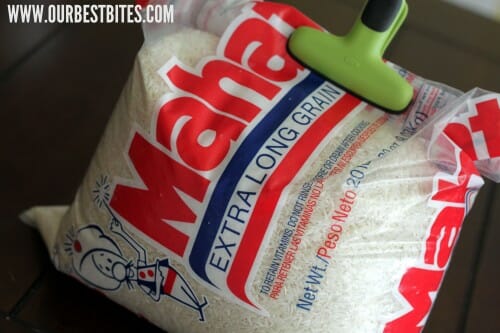
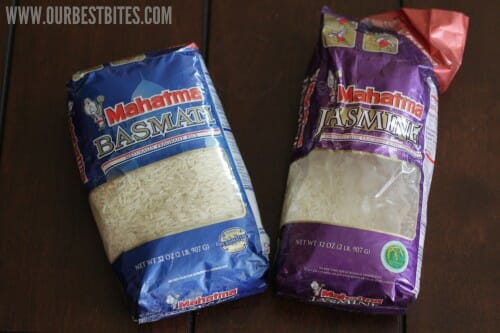
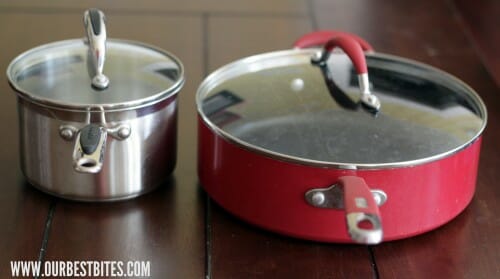
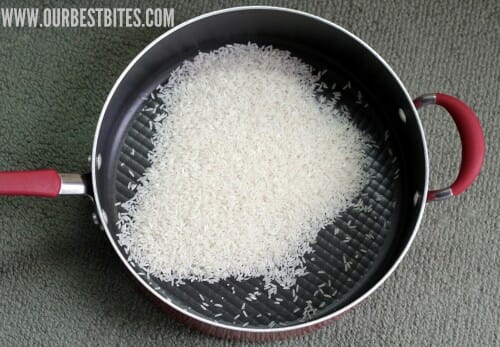

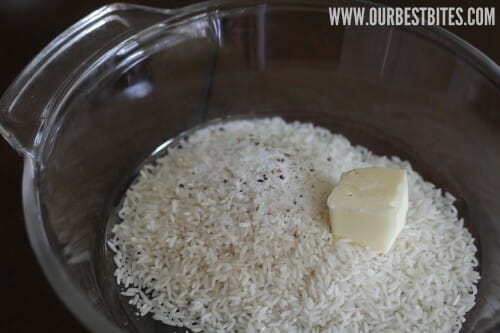
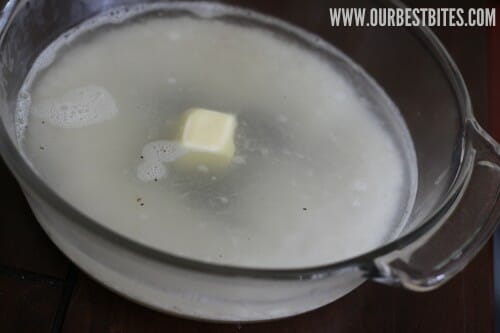
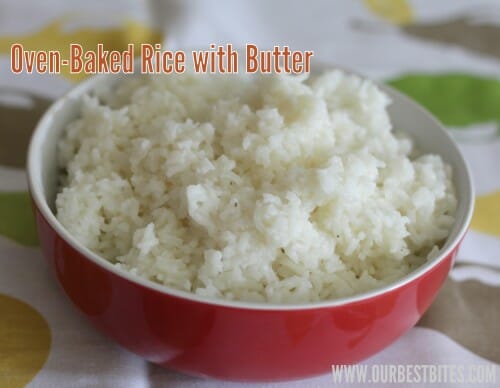
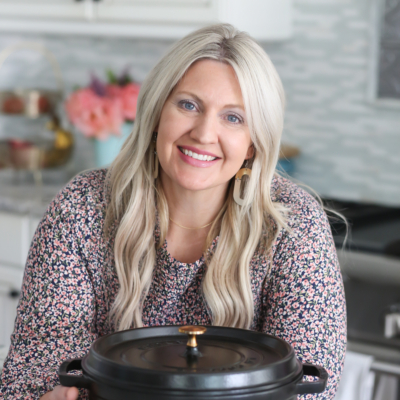







Questions & Reviews
Being a potato eater more than rice eater this post is PERFECT… It has the right amount of information to help me cook rice. Thank you for the time you put into this post. Already pinned so I don’t lose it!!!!
So here’s my question – should you wash your rice first? My mother always washed the rice, and that’s how she taught me. But maybe it’s not necessary anymore?? Am I just old fashioned?
I just read on the back of a bag of rice today that you shouldn’t rinse it because it reduces the nutrient content of the rice- I didn’t know that but there you have it.
We’ve always rinsed Basmati rice twice, according to the packaging. Any other rice, its just an extra step that I’d rather skip. In Japan, rice is almost always rinsed around 3 times (until it feels right) and in Korea, water from rinsing rice is often used in cooking, but not for the actual rice.
This post wasn’t boring at all. Really interesting, in fact!! I love love love rice. It’s the Brazilian in me!! I could seriously eat it at every meal. I’m a little weird because two of my favorite rice comfort foods are plain rice with soy sauce or plain rice with italian dressing. I know, weird, but soooo good. I almost always use a rice cooker, though, with 2 cups rice and 3 cups water. My favorite rice dish is a chicken and rice casserole where you saute the rice with onions and garlic on the stove, add sauteed chicken, cumin, oregano, corn, and salsa and then finish cooking it in the oven. It is frickin’ awesome!!
Rice is definitely a comfort food in our family – especially when cinnamon, sugar and milk accompany it! 🙂
Wow, that’s quite a comprehensive list about rice. I think it’s perfect for a beginner, and I think I’ll try the “poor man’s risotto some day. I’ve always cooked stovetop just following the directions on the package. I’ve tried jasmine rice, but found it bland, I preferred the basmati. I actually also did a post recently on my blog about rice- http://uniqueheartfun.blogspot.com/2012/08/reheating-rice.html.
Does anyone ever get soap like bubbles when they cook rice??? I boil mine on the stove and it always turns out fine, but the pot always fills with large soap like bubbles that over flow the pan and make a huge mess of my stove. When ever I mention this to people they look at me like I’m crazy….am I crazy???
You probably let the water get too hot or your pan is too small. I turn my stove down before the water is boiling completely and then I don’t have a problem with it boiling over. If I let it get too crazy it will definitely boil over when you put the lid on, especially if your pan is smaller.
You are not crazy, Tiffany. This happens to me sometimes too and the rice always turns out fine. I just watch it so it doesn’t overflow and blow the bubbles off or give it a stir.
Love my rice cooker. It’s a cheap one from costco but it makes it right as long as I am careful with the water level. We prefer jasmine rice. 🙂 I need to learn how to cool it on the stove in case we ever lose power. 🙂
I’ll have to try it this way. I have never followed the directions on the back but my dad taught me to bring the water to a boil first, then add oil/butter, then add your rice and salt it. Once that is back to a boil, cover and cook on low for 17 minutes. For a rice/water combo this always works. For something like, say, coconut milk I have to make some adjustments.
I also use the boil method when it comes to rice. Kind of like pasta, but I put the rice in at the start and let it boil away. We like our rice to “pop” open and wait to drain until we see the kernels open. Rinse it, and add a bit of fresh thyme o it while the table is being readied…..so yummy under gumbo!
Thanks, this was very informative! Sadly I’ve been using instant white rice for about 18 years of cooking, and it wasn’t until the past year or so that I have ventured into something different! I’m in long need of a change 🙂
Thanks for all the great info!! I seem to go through phases with my rice – soemtimes it turns out sometimes it doesn’t, even though I follow the same method. I love basmati rice the best, but my husband prefers jasmine – so we have jasmine, ha ha! Question: to rinse or not to rinse?
i have just a generic japanese rice cooker…no idea what brand. i put a little more water in than the line of rice (if i’m cooking 2 cups of rice, i put the water a little above the 2 line). when it’s done, i crack the lid for about 10-15 minutes to let the steam out and let the rice settle a bit, then i stir it up and it’s perfect. hawaii is also known as the land of eating rice 🙂 most everyone has a rice cooker there.
I completely echo what Diane and Linda said–Zojirushi is definitely the way to go if you’re buying a rice cooker! I’d always made rice on the stove but got the Zojirushi as a wedding gift 3 years ago and it makes perfect rice every time!!!
When I do cook rice on the stove, I use the “old country” method that my mom taught me (who learned it from her mom, who was from China), and that was to measure the amount of water to use by placing your fingertip on the top of the rice and the water level should reach your first joint. Cook on medium, half-covered on the stove, then when the water’s boiled away, cover completely and cook on low for 15 minutes. I do this when I’m making Cuban rice (rice, olive oil, salt, lime juice) because it’s too messy to do it in the rice cooker and the rice comes out perfectly every time!
My dad showed me that “old country” method too (my parents are Taiwanese)! I didn’t know that anyone else knew about that method.
This is a great resource. Did you know you can also boil rice like you would potatoes? America’s Test Kitchen calls it Foolproof Rice.
Being Puerto Rican, I know my way with rice! I prefer medium grain, though. Not too sticky, not dry, just perfect. And its so easy to make: 2+2+2+2!
Bring 2 cups of water, 2 tablespoons of vegetable oil and 2 teaspoons of salt to a boil. Add two cups of medium grain rice. When it boils again, lower heat to medium until water is absorbed. Lower heat to low, stir and cover. Cook for 15 mins. Stir again, cover and cook for 15 more minutes. That’s it! If you want a more tender grain, use 2 1/4 cups of water instead of just 2 cups. Enjoy!
I love rice. I eat rice with my rice. I recommend any rice cooker by Zojirushi. I’ve NEVER made terrible rice with this bad boy. I have model NS-RNC18A. I don’t even measure it. I throw in the rice and water and measure it with my finger. Water line should be twice as high as rice line. Perfect. If my rice cooker should ever stop working (shudder), I’ll be back on this page like white on rice. 😉
I love my rice cooker–especially after I learned your tip of adding a splash of vinegar. But I want to try your oven cooked method with roast chicken sometime. And it’s on my to do list to try brown rice using Sara’s tutorial. Thanks for sharing your expertise!
I grew up with only Jasmine rice in my household, being as there’s heavy Thai influence in my family’s cooking. Nothing beats the smell of jasmine rice, it’s the one starchy side dish (or filler) that I will happily eat by itself. Also amazing with NamPla (thai fish sauce) and diced jalapenos on it. High elevation cooking here; 1c rice to 1.5c water, bring to boil, cover and simmer until I remember it’s on the stove. Worst case scenario, the bottom will get dried out and crusty – then we just scoop off the fluffy stuff on top. Otherwise it’s usually perfect.
I always used to cook it in the oven. I recently learned about the “abundant water” method, where you cook rice like you do pasta, in a large pot of water, and then drain it when it is done. The great part is that is is faster than the oven and the grains all end up separate and the texture is wonderful. And it never burns! I found this at Cooks Illustrated:
How do I cook rice so that the grains stay separate even when they cool?
Learning how rice cooks helps to explain why the unorthodox method of boiling rice works best for rice salad. Starch granules, which are the primary component of rice, tend not to absorb water. As you heat rice in water, however, the energy from the rapidly moving water molecules begins to loosen the bonds between the starch molecules so that water can seep in. This in turn causes the starch molecules to swell, softening the rice but also making it more sticky, or “starchy.” If you use the “abundant water” method for cooking long-grain rice, some of this starch leaches into the water, which is ultimately drained off. The result is a pot of long-grain rice with less concentrated starch. This is what allows the grains to cook up so remarkably light and separate and to maintain that consistency as they cool to room temperature.
I have been having rice discussion with my 16 year old. He likes rice and I think it is something he should start trying to make on his own.
I have been trying to teach him the microwave method (I do the same thing, 10 minutes, wait then another 5 minutes)
oven – never thought about that one – I will definitely try
one trick I learned when working in a kitchen store years ago, stovetop, use a heavy pan such as a le cruset, once water has come to a simmer, cover, turn off and leave it alone for 20 minutes.
Thanks for such a great article! I always think that rice should be the simplest thing to cook, yet I always have trouble with it.
Two words. Rice cooker. I love them. I’ve never made rice on a stove and liked it. Worth every inch of cupboard space it takes up. It steams vegetables like a charm too. But… If I ever need to cook rice on a stove you better bet I’ll be back to this post. 🙂 lots of great info!
This is great information! Growing up my mom always cooked rice in a rice maker – but when I got to college my roommate was Puerto Rican and always made rice on the stove top. I learned from her and now I mostly make my rice on the stove 🙂
I’ve always cooked rice on the stove the way you described with toasting it first and it always turns out great. But recently we were having rice as a side and there wasn’t going to be any sauce or anything with it so I cooked it with chicken broth, which I had never done before, and it was fantastic. I want to get your cute red skillet and then I want to try cooking rice in that instead of my saucepan. Also, my costco sells another brand of parboiled rice (blue ribbon, I think) and it tastes just like uncle ben’s but costs about 1/3 as much.
Rice may not be the most exciting topic ever, but you gave a lot of good information. Thanks for posting it!
I’d always been taught to add the rice AFTER the water came to a boil. I always ended up with crunchy rice. However, recently I read a recipe that says to add the rice WITH the water and bring it all to a boil at the same time. No more crunchy rice. We also recently made the switch to jasmine rice for almost everything we cook (we usually don’t do risottos or sushi) and the difference is amazing!
To save any pan from scorched food, pour ammonia in the pan, then place the whole pan in a plastic bag and close it up. Let it sit for several hours, then pour off the ammonia and scrub. You might have to do this several times, but if you’ve ruined a good pan, it’s worth the effort.
So helpful! I love risotto and pilaf, but never knew which rices to use when. Thanks for the info! I also can’t wait to try your other cooking methods
We are rice eaters. All our main meals include rice. We cook it one way: boiled.
I loooooooooooooove my Jasmine rice. I kind of see myself as a rice snob too. If the rice isn’t cooked properly, it’s ruined for me. It has to be soft and fluffy. There’s a rice cooker somewhere in my apartment but haven’t exactly used it yet (got it about 3 years ago as a wedding present but we didn’t have enough space in our kitchen for it) so I learned how to make it on the stovetop.
Another rice that I really like is sticky rice. I’m not exactly sure what brand is the best but with my bamboo basket and pot that I can NOW fit on top of my stove because there’s no microwave looming over my stove, I am drooling for some coconut sticky rice. Unfortunately, with gestational diabetes I can’t have a lot of it. Like, a quarter cup? Half of a cup of rice ? That’s probably what I’m allowed to have for a snack then wait 2-3 hours to eat again. I mean, SERIOUSLY???? Anyway, I’m going to have to wait until after the baby comes then go crazy.
I’m a self confessed rice snob. American in my opinion is nasty. Jasmine is my favorite. Basmati and Arborio come in tied in second place.
To save yourself a lot of time and headache….buy a rice cooker but do not buy an American brand. Stick with the asian brands namely zojirushi rice cookers. I have one that is now going on its 10th year and I cook rice at least twice a week! I just love the smell of Jasmine rice!
Yes! We have one of those rice cookers & love it! Just fill it up and set the rice type & it does it all for you! Haven’t tried Jasmine but am ready for something new!
I want to completely DITTO your comment. Jasmine rice is the best and a Zojirushi rice cooker IS the way to go. I have had mine for almost 20 years. I am glad there are other people who know there are other types of rice besides MINUTE RICE.
I don’t know why, but I can NEVER cook rice properly. People said, get a rice cooker. Well I DID and the rice was still burned on the bottom.
I try to cook it in a pan, and no matter how much extra water I add (up to half a cup!!) I still have crunchy rice. I’m starting to think I’m just rice stupid!
I have the same problem! I have been using instant rice or boil in a bag since I can’t get it to cook right!
Honestly I have the same issue, at this point though I just don’t care as long as I get as much as I need. I like to eat rice by itself a lot, but when I cook rice for a dish like omurice or even fried rice, I make more than I need so I can get what I need and avoid the bottom of the cooker.
heheheh dude you need to put two cups of water in 1 cup of rice for rice cooker
and double each for the other so 2cup rice put 4cup water!
email me if doesn’t work! I will guide you through if I will have the time!
enjoy the meal
bye
peace on you
Hi, I’m so glad to share my experience of cooking rice in my clay pot that turns out great. It’s a non-toxic cookware. I cook white and brown rice as well…turns out soft, fluffy and tastier too. There’s no need to add any broth or oil, no need to baby-sit the pot, as the pot does job for you. It cooks without destroying the nutritional cells. Now there’s no issue of sticky rice… my pot cooks beautifully separating each grain from the other. I got mine from Miriams Earthen cookware(online)